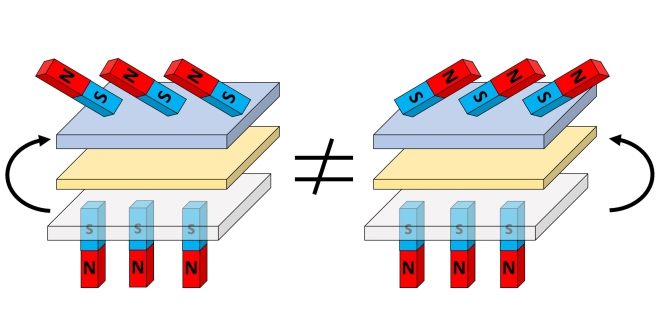Physicists from the University of Glasgow have found a new way to successfully pass data between ultra-thin films using tiny magnets, which they say could lead to new forms of computing.
The new form of magnetic interaction, which pushes a formerly two-dimensional phenomenon into the third dimension, could open up a host of exciting new possibilities for data storage and advanced computing.
The breakthrough adds both a literal and metaphorical extra dimension to ‘spintronics’, the field of science dedicated to data storage, retrieval and processing, which has already had a major impact on the tech industry.
Anyone who’s ever played with a pair of magnets understands that opposites attract – the south pole of one magnet attracts the north pole of the other. While that’s true at the scale most people are familiar with, the way magnets interact with each other undergoes some significant changes as magnets shrink.
At the nanoscale – where magnetic materials can be just a few billionths of a metre in size – magnets interact with each other in strange new ways, including the possibility of attracting and repelling each other at 90-degree angles instead of straight-on.
Scientists have already learned how to exploit those unusual properties to encode and process information in thin films covered in a single layer of nanoscale magnets.
The benefits of these ‘spintronic’ systems – low power consumption, high storage capacity and greater robustness – have made invaluable additions to technology such as magnetic hard disk drives, and won the discoverers of spintronics a Nobel prize in 2007.
However, the functionality of magnetic systems used today in computers remains confined to one plane, limiting their capacity. Now, the University of Glasgow-led team – along with partners from the Universities of Cambridge and Hamburg, the Technical University of Eindhoven and the Aalto University School of Science – have developed a new way to communicate information from one layer to another, adding new potential for storage and computation.
“The discovery of this new type of interaction between neighbour layers gives us a rich and exciting way to explore and exploit unprecedented 3D magnetic states in multi-layered nanoscale magnets,” said Dr Amalio Fernandez-Pacheco, an EPSRC Early Career Fellow in the University’s School of Physics and Astronomy.
“It’s a bit like being given an extra note in a musical scale to play with – it opens up a whole new world of possibilities, not just for conventional information processing and storage, but potentially for new forms of computing we haven’t even thought of yet.”
Like this content? Sign up for the free PCR Daily Digest email service to get the latest tech news straight to your inbox. You can also follow PCR on Twitter and Facebook.
Read the latest edition of PCR’s monthly magazine below:
 PCR Tech and IT retail, distribution and vendor news
PCR Tech and IT retail, distribution and vendor news
